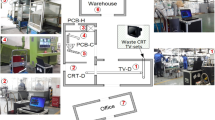Abstract
Airborne lead levels were assessed in nine workshops, three each from battery, electronic repair, and welding sources within the Kumasi Metropolis in Ghana. Samples were collected at 0, 2.5, and 5.0 m away from the emission source at the workshops during working hours and another at 5.0 m during break hours. Airborne lead particulates were collected and analyzed using the filter membrane technique and flame atomic absorption spectrophotometry, respectively. There were significant differences (p ≤ 0.05) among the air lead levels from the workshops. Workshop 3b produced the highest significant values of air lead concentrations of 2,820.31 ± 53.89, 2,406.74 ± 71.87, 754.55 ± 72.52, and 549.01 ± 67.30 μg/m3 at distances of 0, 2.5, 5.0, and 5.0 m (break-time measurement), respectively, while workshop 1w significantly produced the lowest air lead concentration values of 261.06 ± 21.60, 190.92 ± 36.90, 86.43 ± 16.26, and 61.05 ± 3.88 μg/m3 at distances of 0, 2.5, 5.0, and 5.0 m (break-time measurement), respectively. The air lead levels reduced with distance from emission source at the workshops. At all the distances of measurement at working hours, the airborne lead levels were higher than the World Health Organization standard of 50 μg/m3 and exceeded the threshold limit values of 100 to 150 μg/m3 recommended in most jurisdictions. Workers and people in the immediate environs were exposed to air lead levels that were too high by most international standards, thus posing a serious threat to their health.
Similar content being viewed by others
References
Abdel Hameed, A. A., & Khoder, M. I. (2000). Evaluation of airborne lead in the welding working environment. Journal of Environmental Monitoring, 2, 119–121. doi:10.1039/a906169j.
Asogwa, S. E. (1979). The risk of lead poisoning in battery chargers and the possible hazards of their occupation on the environment. Nigerian Medical Journal, 9, 189–193.
Awad El-Karim, M. A., Hamed, A. S., Elhami, Y. A., & Osman, Y. (1986). Effects of exposure to lead among lead-acid battery factory workers in Sudan. Archives of Environmental Health, 41(4), 261–265.
Derazne, E., Kahen, E., Kybski, M., Shain, R., & Ashkenazi, R. (1996). Monitoring of blood lead levels in workers overexposed to occupational lead. American Journal of Industrial Medicine, 29, 187–193. doi:10.1002/(SICI)1097-0274(199602)29:2<187::AID-AJIM9>3.0.CO;2-P.
Essa, K. A. (1999). Lead, the ugly trace element: Occurrence effects, screening and treatment. Eastern Mediterranean Health, 6(4), 796–802.
Farr, G. (2004). Why heavy metals are a hazard to your health. BecomeHealthyNow.com, Inc. http://www.becomehealthynow.com.
Freed, R. D. (1992). How to use MSTAT-C to analyze on-farm experiments. Michigan State University, East Lansing, MI, USA: Farming Systems Conference.
IPCS (1977). Environmental health criteria 3. Lead. Geneva: World Health Organization.
UNEP (2002). Technical guidelines for the environmentally sound management of waste lead-acid batteries. Geneva: Technical Working Group of the Basel Convention.
US EPA (1999). Integrated Risk Information System (IRIS) on lead and compounds (Inorganic). National Centre for Environmental Assessment, office of Research and Development, Washington, D.C.
Vanclay, E. (1994). Airborne particulate lead levels measured by Flame AAS, AA-115. Varian Australia Pty. Ltd. http://www.varianinc.com/media/sci/apps/aa115.pdf.
World Health Organization (1980). Recommended health-based limits in occupational exposure to heavy metals. WHO Technical Report Series, no. 647.
Author information
Authors and Affiliations
Corresponding author
Rights and permissions
About this article
Cite this article
Dartey, E., Adimado, A.A. & Agyarko, K. Evaluation of airborne lead levels in storage battery workshops and some welding environments in Kumasi metropolis in Ghana. Environ Monit Assess 164, 1–8 (2010). https://doi.org/10.1007/s10661-009-0869-x
Received:
Accepted:
Published:
Issue Date:
DOI: https://doi.org/10.1007/s10661-009-0869-x




